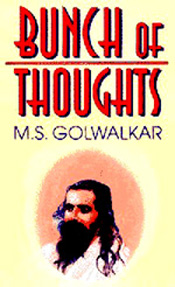|
 Page1
Page1
Bunch Of Thoughts
M.S. Golwalkar
Introduction
Independent India is engaged in a many-sided renaissance and reconstruction more or less consciously directed to what may compendiously be called nation-making (or remaking) in an image more adequate to the needs of the present and future of India as a strong, creative nation guiding the destinies of its people in accordance with a worthy and inspiring charter of life.
This era commenced roughly with the emergence and work of Raja Rammohan Roy in the beginning of the last century and has continued to the present day through the life-effort of notable thinkers in many fields like Ramakrishna and Vivekananda, Swami Dayananda, Sri Aurobindo and Lokamanya Tilak, Gandhi and Tagore, Dr. Hedgewar and Veer Savarkar. These are only typical names and do not exhaust the galaxy.........
In the present phase of the struggle (and triumph) with the British Power (typifying the entire gamut of foreign ideas and ideals) we have a similar period as in many periods in the past of the self-recollection and re-assertion of the national self-consciousness and of a conscious search for the roots of aeroculture as the living points on which we may regraft current life and foster it to vigorous growth and power. In this many-sided effort, the image of Indian culture as the pattern of nation-building is laid over with many confused notions from the West and from distorted ideas of the past of our own life.
Mohandas Karamchand Gandhi introduced a powerful leaven into this maelstrom of ideas, impulses and images having many elements congenial to the spirit of Indian Culture. Thus the national liberation movement of M. K. Gandhi derived power from the cultural heritage indwelling in the sub-conscious mind of the people.
But unfortunately as the political motif was dominant in the Gandhian movement, the cultural forces it invoked and mobilised were not grasped in their genuine purity and power and were not related naturally and organically to the ideals of politics, economics, social order and values and the many dharmas of the living past. They were all mobilised as vague sources of inspiration against the common enemy, namely the foreign rulers. They afforded no positive pattern of the new Indian society and state, economy and social order that was to replace the present order of things under long foreign rule. It was mainly negative, the many types of leaders following the Mahatma being content to put off decisive thinking on positive lines for the post-liberation epoch. Thus we find the Mahatma choosing a person with nothing in common with his ultimate ideas on man, nation and God like Jawaharlal Nehru to succeed him as the national leader. The Nehru Mind is made mostly abroad and in spite of his Discovery of India, Sri Nehru never succeeded in catching the spirit of Indian culture at its best. Thus the blueprint of the new society he is using as Prime Minister and leader of national reconstruction for building independent India is the "socialist pattern of society" which is infinitely more abstract and superficial, more mechanical and charged with unsolved problems of class conflict than the foundational ideas of the past.
Author : M. S. Golwalkar
|